
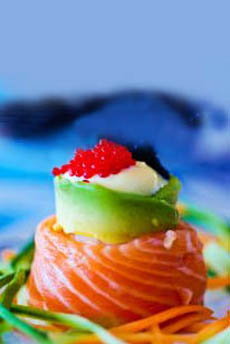
Tiny beads of red and black (dyed) capelin roe, or masago, tops this beautiful sashimi creation. Photo by Bazil Raubach | SXC.
May 2005
Last Updated July 2017
|
 |
Caviar Glossary
Page 3: Caviar, Caspian Caviar, Crème Fraîche & Other Terms With C & D
This is Page 3 of a ten-page glossary. If you’d like to suggest additional words for inclusion, or think we should consider other definitions than those we have provided, use the Contact Us link on this page. You may also enjoy one of our many other food glossaries.
Click on a letter to get to the appropriate glossary page.
a b c d e f g h i j k l m n o p q r s t u v w x y z
This material is copyrighted and cannot be reproduced in whole or in part
without written permission. You are welcome to link to it.
CALIFORNIA OSETRA CAVIAR
See American sturgeon caviar.
CALIFORNIA WHITE STURGEON
See white sturgeon.
CAPELIN ROE or MASAGO
Also called masago caviar, this crunchy roe comes from the smelt fish, used in sushi and sashimi dishes. It lives in the Atlantic and Arctic Oceans. The eggs are small, fluorescent, and mild in flavor. The roe is similar in appearance and taste to tobiko, flying fish roe; but it is smaller, more orange, can have a stronger flavor and is less expensive. As a result, masago is often used on the outside of sushi reverse roles, whereas the more flavorful tobiko is used in a nigiri sushi. (See our Sushi Glossary for more sushi information.) Capelin is also available flavored, including jalapeño and habanero. Talk about fusion food! Also see our Sushi Glossary.
|
|
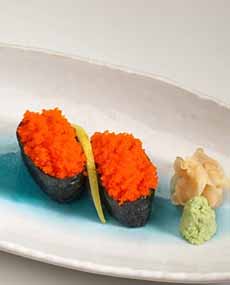
Capelin row, called masago in Japanese. Photo courtesy Catalina Offshore Products. |
CARP ROE
Carp roe is better known in the U.S. as tarama, its Greek word. The delicate roe, which are naturally white, are cured and aged for more than one year to become tarama. Some are dyed red and blended with oil, lemon juice and potentially other ingredients (bread, chopped onions, mashed potatoes) to make taramosalata, the popular pink caviar spread. See tarama.
CASPIAN CAVIAR
This term refers to the roe of the three species of Caspian Sea sturgeon: the Beluga, Osetra and Sevruga.
CASPIAN SEA
A large saltwater lake between Russia and Iran, fed by the River Volga; the major source of sturgeon caviar. The sea bed descends to several hundred meters offering the bottom-dwelling sturgeon vast areas of rich nutrition, as well as the sandy bottom and steady current the species prefers.
|
|
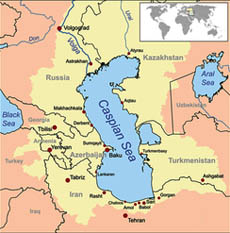
The Caspian Sea is enormous. Map courtesy Wikimedia Commons. |
The Caspian Sea is bordered by Russia and Kazakhstan to the north, Kazakhstan Turkmenistan to the east, Iran at the southern end and Iran, Azerbaijan and Russia on its eastern shores. It has a surface area of 143,244 square miles and a maximum depth of 3,363 feet. Compare this to our Great Salt Lake, which has a surface of “just” 1,700 square miles, or to Lake Michigan, which has a surface area of 22,400 square miles and a maxim depth of 923 feet, to realize how huge and deep the Caspian Sea is. Unfortunately for the sturgeon population, which has declined by more than 90% in the past decade, the World Wildlife Foundation WWF predicts that the native Caspian sturgeons will be extinct by 2012 (they are on the endangered species list). This is a result of damming the rivers where the sturgeons spawned, for larger commercial interests, as well as the heavy pollution of oil and nuclear waste via Soviet industry. The Iranian coastal waters, at the south end of this vast sea, are said to have remained unpolluted.
CAVIAR
Caviar, when the term is used by itself, refers to eggs harvested from any species of sturgeon, although traditionally it referred to Beluga, Osetra, and Sevruga and sturgeon roe from the Caspian Sea in Russia and Iran. However, the rising popularity of other types of fish roe in modern cuisine and the growth of the American hackleback and white sturgeon farming, have caused the definition to broaden. Today, the term “roe” is rarely used and basically any fish egg is referred to as caviar; although in the U.S. only sturgeon caviar can be labeled simply “caviar” and non-sturgeon caviars must be modified with the name of the fish (salmon caviar, whitefish caviar, etc.). Caviar was originally prepared in ancient times by the Chinese, from carp roe. The technique was learned from them by the Persians (antecedents of modern Iran), who were the first to use the technique on their supply of sturgeon.
|
|
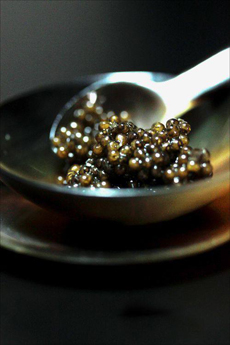
A thing of beauty! Photo courtesy Petrossian Caviar. |
The word “caviar” comes from the Persian khavyar, from khayah, egg. While Western Europeans and Americans use the word caviar (it came into the English language in the 16th century), the Russians do not: They refer to fish roe of all kinds as ikroj (pronounced EEK-ruh with a rolled “r”—the Japanese adapted the word to ikura).
CAVIAR D’AQUITAINE
A brand name for French-farmed baerii osetra caviar. Acipenser baerii is easy to farm, and is cultivated in a number of countries.
CHOUPIQUE
The Cajun name for bowfin caviar.
CITES
The United Nations’ Convention on International Trade in Endangered Species. CITES is an international treaty drawn up in 1973 to protect wildlife against over-exploitation, and to prevent international trade from threatening species. CITES responded to high levels of poaching and illegal trade in 2001 by halting the caviar trade by Azerbaijan, Kazakhstan, Russia and Turkmenistan. It proposed the ban on exporting Caspian caviar by the Russian states that border the Caspian Sea.
CORRECT CAVIAR
Correct caviar is a relatively new term for caviar that is produced without killing the sturgeon. It is also processed cleanly, without the borax* traditionally used as a preservative. It is only in recent years that the dwindling stock of sturgeon engendered sustainable farming; however, farmed sturgeon were still killed to remove their egg-filled ovaries. Now, with correct caviar production, the sturgeon naturally releases the eggs from the ovary into the belly from where they are stripped; like a Caesarian section, the belly is sewn up so the sturgeon can reproduce again. Learn more at VivaceCaviar.de.
|
|
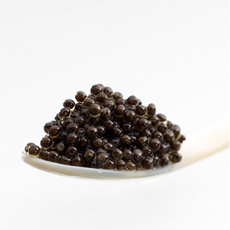
A spoon full of correct caviar. Photo courtesy Vivace Caviar. |
_______________
*Borax as a food additive is banned in the U.S. As a result, caviar produced for sale in the U.S. contains higher levels of salt to assist preservation. Borax was added to the Substance of Very High Concern (SVHC) candidate list in 2010. More information.
CRÈME FRAÎCHE
French for “fresh cream.” Cultured, thickened whole cream. In France it is unpasteurized; U.S. laws do not allow fresh, unpasteurized products to be sold (pasteurization kills good, flavor-enhancing bacteria as well as potentially bad bacteria). When crème fraîche is unavailable, sour cream can be substituted; although sour cream is thicker, heavier and has a more pronounced flavor. You can make your own with this crème fraîche recipe.
CULTURED CAVIAR
Another term for farmed caviar. See aquaculture and sustainable caviar.
|
|
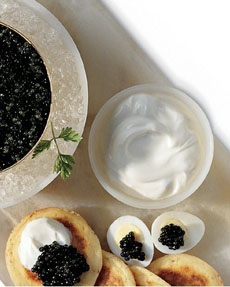
It was invented in France, but crème fraîche made in America is just as delicieuse. Photo courtesy Kendall Farms. |
Continue To Next Page: Caviar Terms With E to H
Go To The Article Index Above
Lifestyle Direct, Inc. All rights reserved. Images are the copyright of their individual owners.

|









